Panama food and drink doesn’t get the international credit it deserves. But food of Panama is really a fascinating combination of cultures.
Lying on the crossroads between North America and South America, Panama has always been a country where trade is vital, especially for the United States.
The country is famous for the Panama Canal in Panama City which allows ships to navigate from the Atlantic to the Pacific, without having to go all the way around.
It’s also a popular spot to learn Spanish.
The hot climate in the country means that crops here include plenty of tropical fruit and starchy vegetables.
However, unlike some of its neighbours the cuisine in Panama foods are not quite as spicy and tends to have milder flavours in its recipes.
The country is quite a narrow strip of land in between two oceans, so naturally seafood is also very common in food from Panama.
Panama Food History

Like many of the other countries of Central America, much of the recent history of Panama was as a part of Spain.
Naturally, this means that many of the dishes and cooking styles do have a Spanish influence.
Like many countries along the Caribbean coast, much of Panamanian cuisine is influenced by slaves brought from Africa to work in Central America. Some dishes are quite similar to food in Jamaica, Cuba and Colombia.
This means that many of the dishes in the country also have an African flavour. Often found further inland, there are also the tasty indigenous dishes.
These dishes tend to be a little heartier and make good use of the fruit and vegetables native to the region.
Traditional Panamanian Cuisine
Sancocho
Often considered to be the national dish of Panama. Panama sancocho is a soup that can be found in almost every restaurant.
You may also find it served in fairs and in a container from a food truck in some places.
The key ingredient in the soup is chicken, which is slow cooked to give a very flavourful broth. The chicken is diced and combined with onion, yucca and corn, before being cooked with the broth.
This is seasoned with garlic, oregano, pepper and garlic, before being cooked. Generally the chunks of vegetable are quite large, popping out of the broth when it is served.
Arroz con Guandú y Pollo Guisado
Guandú are a variety of pigeon peas that are grown by most families in Panama, and they are a common ingredient in many dishes.
In this dish the green variety are combined with white rice before being fried and then simmered with water.
Pollo guisado is chicken that has been stewed with cilantro, onion, tomatoes, peppers and achiote. They are then served together for a tasty meal.
Guacho de Mariscos
This Panama food is a rice dish that has some similarities to risotto. Guacho can be prepared with any type of meat, and there are several different varieties to try.
This seafood version is common across many of the coastal areas of the country, and can be prepared with many different types of seafood.
For this the rice is fried with the seafood, onion and bacon, along with a spicy chilli puree. The rice and seafood are then cooked in the broth until it is ready to serve.
Sao
This is one of the dishes that is best to try and enjoy before you learn about the ingredients. The dish is one that is made from pickled pig’s trotters that are usually prepared in advance.
The dish is actually quite similar to ceviche, in that the pig’s feet are cooked until soft, but then served with plenty of lime juice.
The chopped trotters are served with a salad of onions, cucumbers and pepper, before being topped by the lime juice dressing.
Tamal de Olla
Tamal de Olla is one of the dishes that certainly shows off the influence that the Spanish conquistadors had on the local cuisine.
A casserole that is generally made with pork, this dish has some interesting ingredients that give it a sweet and savoury flavour.
The pork is cooked with olives, vinegar, raisins and capers.
This is then usually served with sofrito, which is a combination of onions, peppers, celery and maize that is all finished off together in the casserole dish.
Yuca Frita
This is one of the most common side dishes that are found across the country. In Panama typical food almost always includes yuca as a side.
The yuca is quite a starchy and hard vegetable before preparation, so they are usually boiled first to help soften the flesh.
They are then sliced lengthways to make them into a chunky finger shape. The strips of yucca are then fried until they are golden and crispy.
They can be served as a side dish to almost anything, while some people will also eat them as a snack.
Ensalada de Papas
This side dish is found in many areas of the country, and it can be easily spotted because of its distinctive bright pink colour.
At its heart this is a potato salad that has been prepared with a beet to give it the bright colour. The potatoes are boiled and then diced, while they are often combined with carrots and celery along with the beet.
This is then prepared with a dressing of mayonnaise and mustard which is smothered over the vegetables to serve.
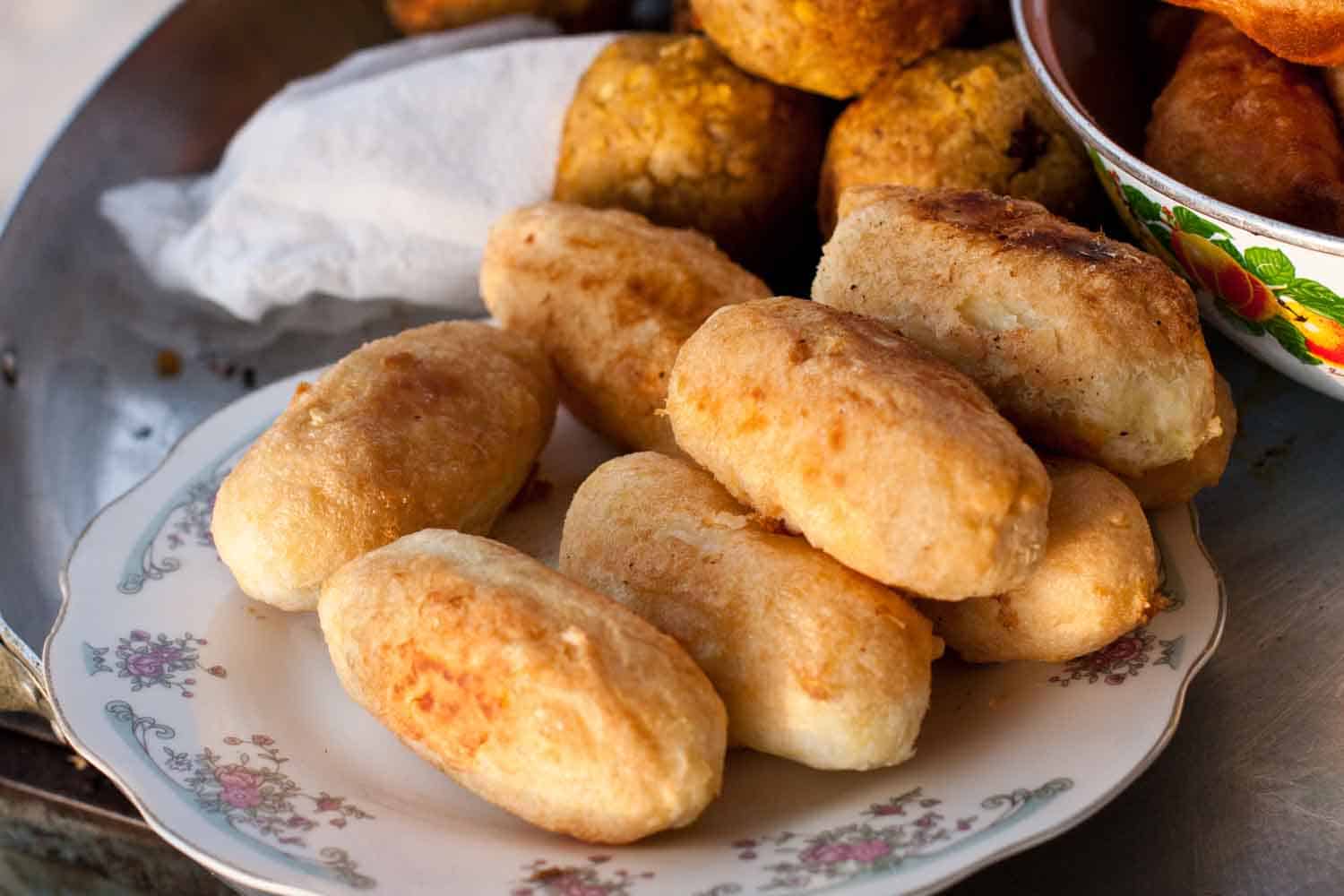
Carimañolas
This dish is similar to enyucado in Costa Rica and muchin de yuca in Ecuador.
Here the flesh of the vegetable is mashed and made into a dough that can then be stuffed and fried.
The filling for the carimañolas can vary depending on where you are and the meat that is available in those areas, but beef and chicken are among the most common fillings.
The package is then covered in breadcrumbs before being deep fried.
Served hot, the carimañolas are usually eaten as snacks, but can also be served as a side dish.
Carne Entomatada
Panamanian cuisine is often prepared as a meal for busy families and doesn’t require too much effort.
Carne entomatada is most commonly prepared with beef, the entomatada sauce can also be served with chicken, pork or whatever else is available.
The sauce is made with diced tomatoes and chopped onions that are then seasoned with garlic and cumin.
The meat is usually fried with the onions before the tomatoes and rest of the ingredients are added to the pan, and simmered to thicken the sauce.
This dish is often served with yuca frita or fried potatoes.
Tamales
Tamales are thought of as only a food in Mexico. But they exist across Central and South America, and there are several differences to be found between those found in Mexico and Panama.
Generally they will still be wrapped in plantain leaves which are then steamed.
The key to a tamale is the dough that is made from cornmeal, and in the majority of cases the filling for the dough is chicken.
When they are eaten, the Panamanian tamales are a little softer with a moister texture than those found elsewhere.
These are a delicious meal that can be found in many places across the country.
Mondongo a la Culona
Offal is a common ingredient in many parts of Latin America. Mondongo is found as a soup in most places from Mexico through Colombia, and is a very popular Honduran food and Nicaraguan food.
The Panamanian version has a much thicker sauce and is almost a stew.
The strips of beef tripe are combined with chorizo, carrots, onions and chickpeas before being slow cooked to soften the meat.
The sauce is generally from a tomato base that is supplemented with olives, garlic and annatto seeds to give it the flavour.
The name of the sauce is an interesting one, as it roughly translates as the stew of a lady with a big bottom. The less investigation into that name the better!
Hojaldras
One of many typical Panama breakfast foods, these fried dough slices are a staple of the Panama breakfast table.
The dough is very simple to make and is made with flour, oil, sugar and water.
The key to the preparation is that the dough does need to be prepared the previous evening, and is allowed to rest overnight.
The dough is then separated into little balls that are rolled quite thin before being deep fried.
The hojaldras are then topped with slices of white cheese or a fried egg to make a tasty breakfast.
Pernil de Pueco al Horno
Meat plays a key part in the meals of the majority of Panamanian homes, and this pork leg dish is ideal as a family meal.
The key here is to create the tasty marinade that will permeate through the meat to give it a lovely flavour.
The marinade is made by combining Dijon mustard, soy sauce and oregano, and is rubbed into the meat before cooking.
The pork leg is then roasted in a shallow layer of broth to keep the meat moist. This can then be served with a variety of side dishes.
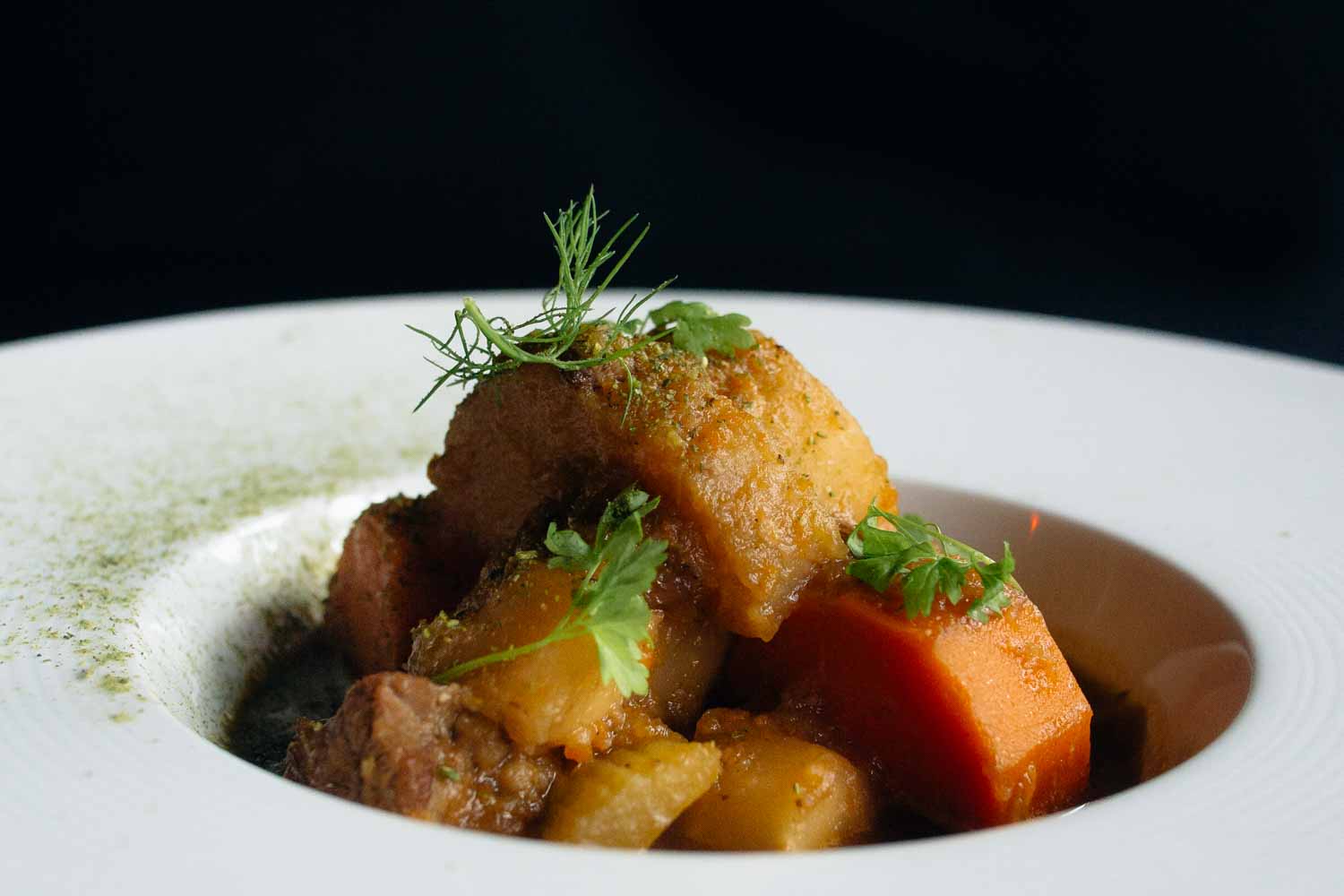
Carne Guisada
This is another of the stews that is a key part of Panamanian cuisine, and this dish is one that is prepared with beef.
The stew combines, peppers, tomatoes, chili peppers and onions, which are then slow cooked with the meat.
This is topped with a few cups of broth and is then seasoned before being simmered for a few hours.
Carne guisada can be served with a variety of sides such as rice or tortillas.
This is a common dish on the go for many locals, as it can be prepared and easily reheated.
Chuletas en Salsa de Piña
One of the ingredients that is found in Panama is pineapple, where the tropical fruit can grow quite well.
This gives the sauce a nice sweetness, while the juice of the pineapple is seasoned with garlic, and then this is used for cooking the meat.
For this dish the meat used is generally pork chops, which are then cooked in the pineapple juice before serving.
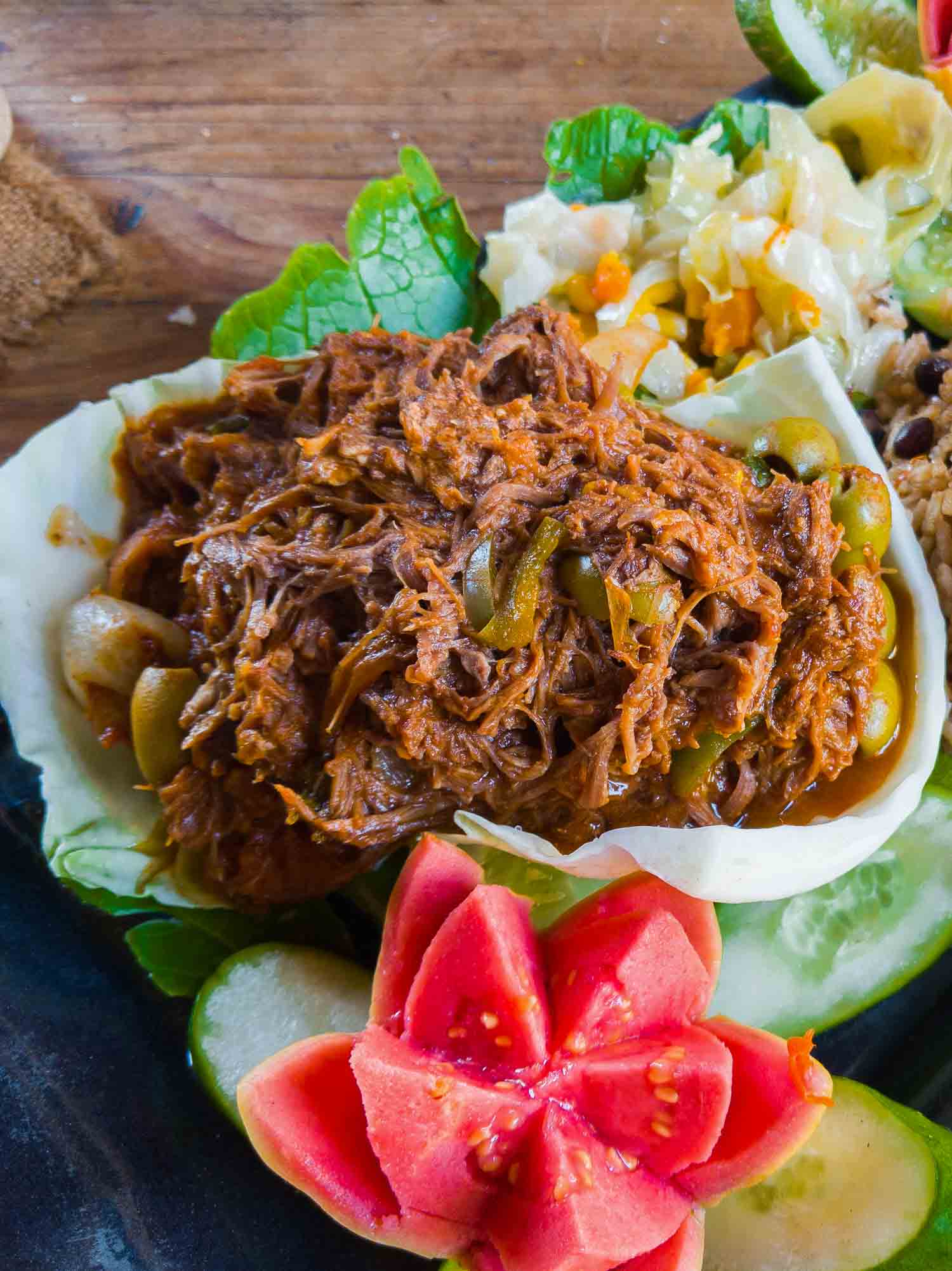
Ropa Vieja y Arroz con Coco
Although ropa vieja is most commonly known Cuban food, you can also find it as a traditional Panama food.
It literally means old clothes and is essentially pulled beef in a rich sauce.
Different areas may use different cuts of beef steak, but this is then cooked with peppers, onions and carrots in a slow cooker.
The sauce is a combination of stock and red wine, which is seasoned with oregano, cumin and salt.
The slow cooking makes the beef tender and pulls apart easily, and is wonderfully delicious.
In this dish the beef is served with rice that has been cooked with coconut milk to balance very well with the meat.
Caldo de Bolas de Verde
Soups do not make as much a part of Panama’s cuisine as they do in some other Latin American countries.
However, this is one of the soups that is particularly common around the coastal areas of the country.
The soup itself is made with a beef broth and seasoned with cilantro, achiote and cumin, and offers a really hearty flavour.
The star of the show for the dish though are the plantain dumplings.
These dumplings are often stuffed with some of the beef, egg and seasoning, to give a tasty surprise when you dig in.
Bistec Picado
Another way in which Panamanians will eat their beef is in this tasty dish that has a bit more heat than some of the other local cuisine.
Here the meat is chopped into strips, to which are added chopped onions and hot chilli peppers.
These are then fried together, and are seasoned with salt, pepper, oregano and a savoury sauce.
The result of this is a simple dish that is commonly served with boiled rice, patacones or yuca frita.
Street Food In Panama
One thing to note about Panama’s street food is that it doesn’t tend to be as varied as that in other Central American countries.
While street food carts are present, you will often find more hole in the wall style cafes.
Nonetheless, where you can find them there are still plenty of treats worth exploring if you get the chance.
Ceviche de Mariscos
There are varieties of ceviche to be found all across Central and South America.
Even in Panama you will find almost every stall holder has their own recipe promising the tastiest ceviche.
In truth, the fish included in the ceviche can vary depending on the catch and what is available, but can include shrimp, sea bass and shellfish.
Easy Peruvian Ceviche Recipe
Panamanians generally cut their ceviche into chunks, and marinate this in a sauce of lemon and lime juice, along with aji and chili peppers.
If you get the opportunity, brave the crowds at the local fish market, and you will find a huge variety available.
Many stalls will also have bottles of home-made hot sauce to enjoy with your ceviche.
Arepas
While arepas are commonly associated with Colombian food and Venezuela to the south, at night arepa stalls are found in most towns and cities.
The arepa is very simply a corn tortilla that is quickly fried to order.
The dough here is made with some of the local white cheese and corn, and is generally worked into a thin tortilla for frying.
These are then used to wrap a range of different fillings, which can include cheese, chicken or other meat fillings.
These can vary from being relatively mild to quite spicy.
However, if you can find one that stuffs the arepa with ropa vieja, it is well worth enjoying!
Arepa stalls are most common in the evenings around Panama, where people will be looking for a snack after a few drinks.
Almojabanos
This fried treat is one that is made with corn flour and the traditional fresh white cheese found in the region.
The dough is made by combining corn flour with a little water and salt before it is worked together. A piece of the cheese is then wrapped in the dough and rolled into a tube shape.
Both ends of the dough are then pinched and twisted to give it a slight ‘s’ shape.
This is said to be the traditional method because then it looks a little like the shape of Panama itself.
This is then deep fried, and when eaten fresh the cheese should stretch deliciously as you crunch through the corn shell.
Almojabanos are such a popular treat in Panama that there is an annual festival held to celebrate the treat.
This is held in town of Dolega, in the west of the country, over a period of four days every January. The festival is said to bring in around twenty thousand visitors to the town every year.
Naturally there are plenty of variations on the crunchy corn snack, with every vendor competing to have the best recipe.
Plantanitos
Who doesn’t want fried plantains as chips?
Plantains are one of the crops that have proven to be particularly successful in Panama.
They are grown in many areas of the country, and while these fruits have some similarities to bananas, they offer a very different taste.
They can be prepared in several different ways, but here the plantains are skinned and then sliced very thinly.
The slices are lengthways to give a longer chip, and these slices are then deep fried, before being seasoned with plenty of sea salt.
These plantanitos can be eaten by themselves with a sauce or a dip as a snack, or from time to time can also be served as a side dish.
These are often found in mobile stalls in the street during a market or festival.
When thinly sliced the plantanitos cook in just a minute or two, and are usually served in a paper bag.
Bollos
These little balls of corn dough are a Panamanian treat that is prepared in a similar way to tamales.
The dough is made of corn and the finished product is actually prepared in the husk of the corn.
There are several varieties usually available, but these often are stuffed with chicken or pork. They will also often be stuffed with some of the fresh white cheese common in this part of the world.
Once the dough is ready to cook, it will be wrapped in the husk which is then tied closed for steaming.
Street vendors will often have pans of bollos cooking early in the morning. They are usually eaten as a breakfast food, along with a slice of cheese.
Panama Desserts
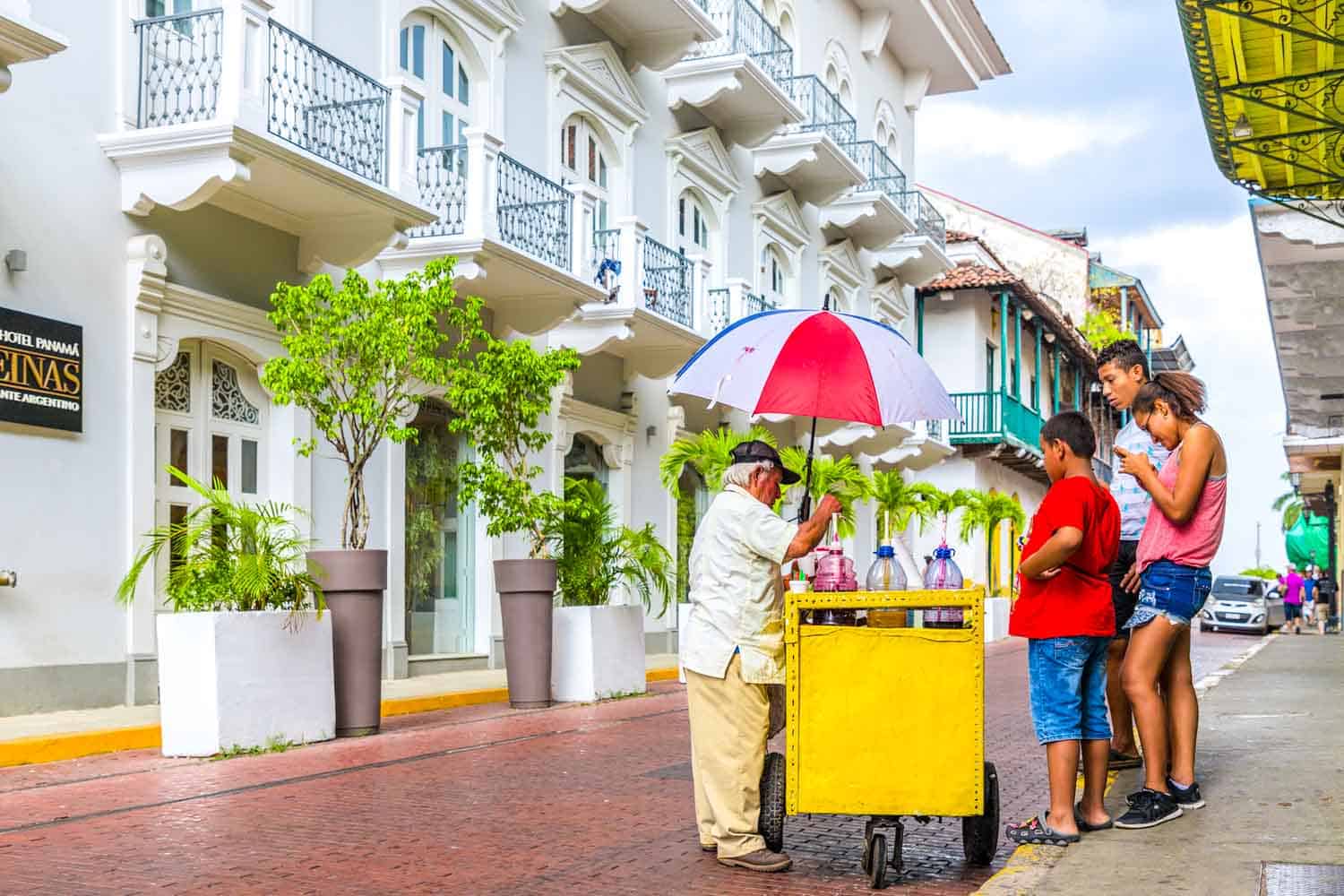
Huevitos de Leche
This is definitely one for those who have a sweet tooth. It is one of the most sugary desserts that you will find in Panama.
Particularly popular in the inland mountains of Panama, there are often stalls selling small packets of huevitos de leche.
This is a milk candy that is essentially made by cooking milk and sugar together with shredded coconut.
A time intensive dessert, this is then cooked slowly until it has a thick consistency.
This is then made into a series of small balls or other shapes before being placed in the refrigerator to set.
Bienmesabe
Often compared to dulce de leche, this sweet and creamy Panamanian dessert is definitely one to look out for.
This is generally made with a combination of fresh milk and evaporated milk.
These two liquids are combined with rice and lots of brown sugar before being slow cooked to deliver a caramel like finish to the dessert.
This is often made for special occasions, as it requires a lot of effort and constant stirring during preparation.
Once the bienmesabe is ready to serve, it is poured into a circular mould made from pineapple leaves, before being wrapped in a banana leaf.
The name of the dessert is a composite word putting together ‘bien me sabe’. This literally translates as tastes good to me. Most people who try this dessert will usually agree!
Bolitas de Tamarindo
These small but sweet treats are found across Central America and the Caribbean, but are very popular here in Panama.
The tamarind tree grows well in the tropical surroundings, and they can be found in many parts of the country.
The flesh of the tamarind is seeded and peeled before being combined with a generous portion of sugar.
This is then worked into a dough consistency before being formed into the little balls that you will see.
These balls are then coated in a little extra sugar before being allowed to rest before serving.
Ron Ponche
Strictly speaking this is one of many Panama drinks rather than a dessert. But it is certainly one of the best ways to end a meal in Panama.
This is the Panamanian version of eggnog. Similar to Cuban crema de vie and the Honduran drink rompopo, it is very sweet, but with the slight hit of rum as well.
Crema de Vie: Cuban Eggnog
Ron ponche is generally enjoyed around the festive period, and is found almost everywhere at that time of year.
The drink is made with a generous measure of rum that is combined with milk, condensed milk and egg yolks, along with some sugar and vanilla for flavour.
This drink generally needs to be prepared in advance, but is then served chilled.

Cocadas
This is one of many Panama dishes that the Spanish conquistadors brought to the country. It’s also a common Peruvian dessert.
Coconuts are another of the great tropical crops that grow well in Panama. These little cookies make great use of them.
They have a crunchy texture. It is just a little crumbly with the coconut that has browned nicely in the oven.
To make them the coconut meat is worked into a dough with sugar and condensed milk. Vanilla and almond are added for flavour.
This is then cooked in the oven until golden brown and cooled before serving.
Unlike cherry balls, they are available all year long and not just considered a Christmas dessert.
Raspado
Also often called a raspao, this is a dessert made with shaved ice. It is the ultimate way to cool down on a hot day.
There are a range of different toppings and sauces that are usually available to accompany the ice.
The shaved ice is served in a plastic cone or cup, topped with condensed milk, fruit chunks or syrup and sugar.
These colourful treats are also often provided with a straw as much of it melts while you eat.
It’s one of the most popular drinks in Colombia, but called a cholado.
Sopa Borracha
While rum is a key ingredient in the ron ponche that is a very popular drink. It isn’t the only dish on the dessert menu where rum makes an appearance.
This is a soaked sponge cake. While it uses a traditional sponge cake as a base, it’s what it is soaked in that makes it special.
The syrup is rum combined with sherry, sugar, lemon, cinnamon and cloves. It is used to generously soak the sponge once it has been prepared.
When the cake is served, it is generally accompanied by plenty of raisins and prunes.
The cake is usually found in celebratory events like weddings and baptisms. Most events serve at least one rum sponge cake.
The name itself translates as ‘drunk soup’, which is definitely a reflection of how much alcohol is used in preparation.
Pin it: Panamanian Food
Yuca frita (c) Larry, Hojaldras (c) hachebegeme, arepas (c) NH567, plantanitos (c) anokarina, raspao (c) Jimmy Gomez N,
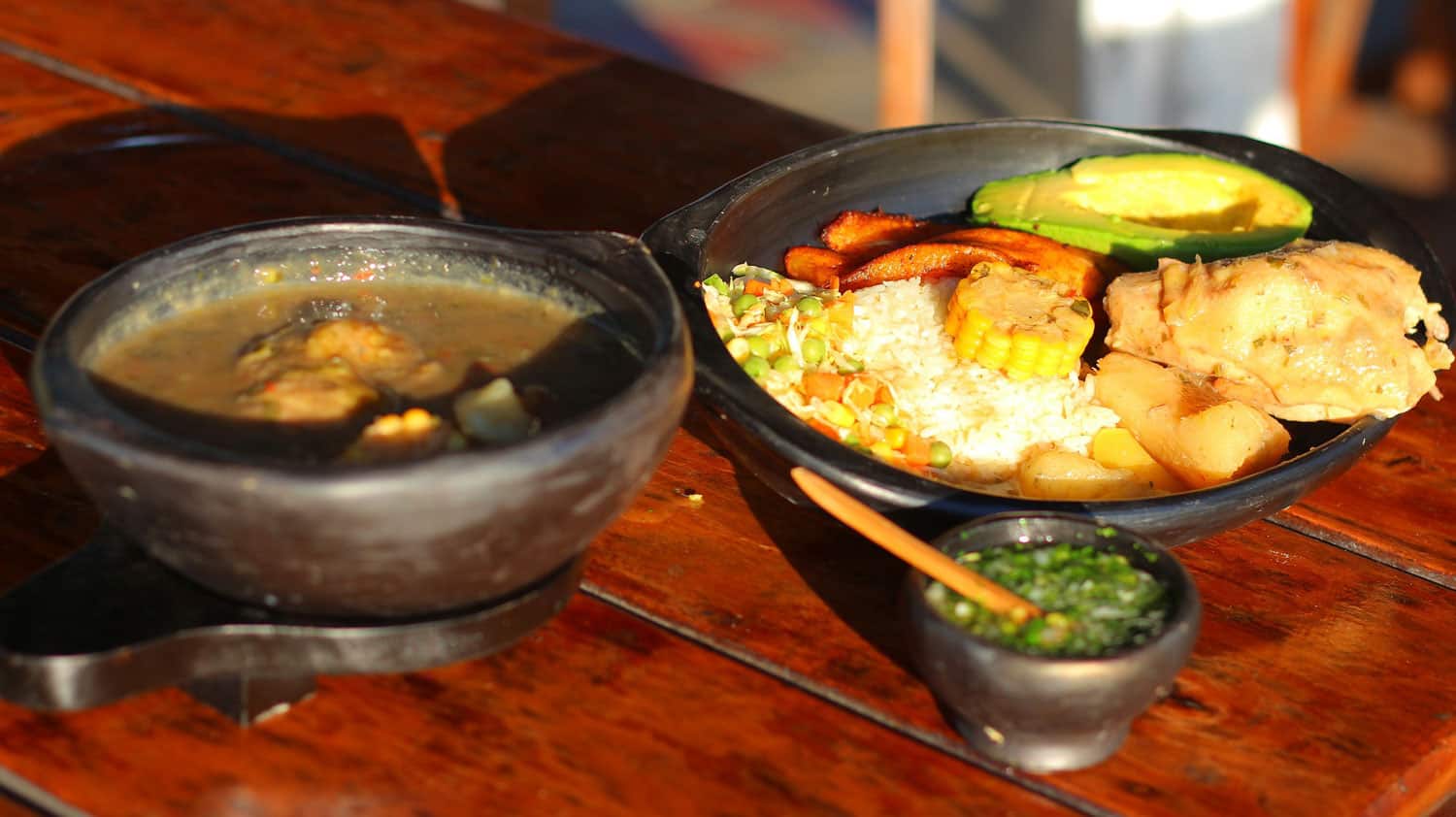
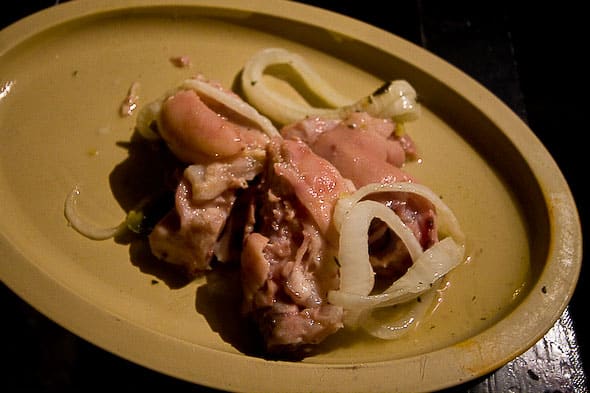
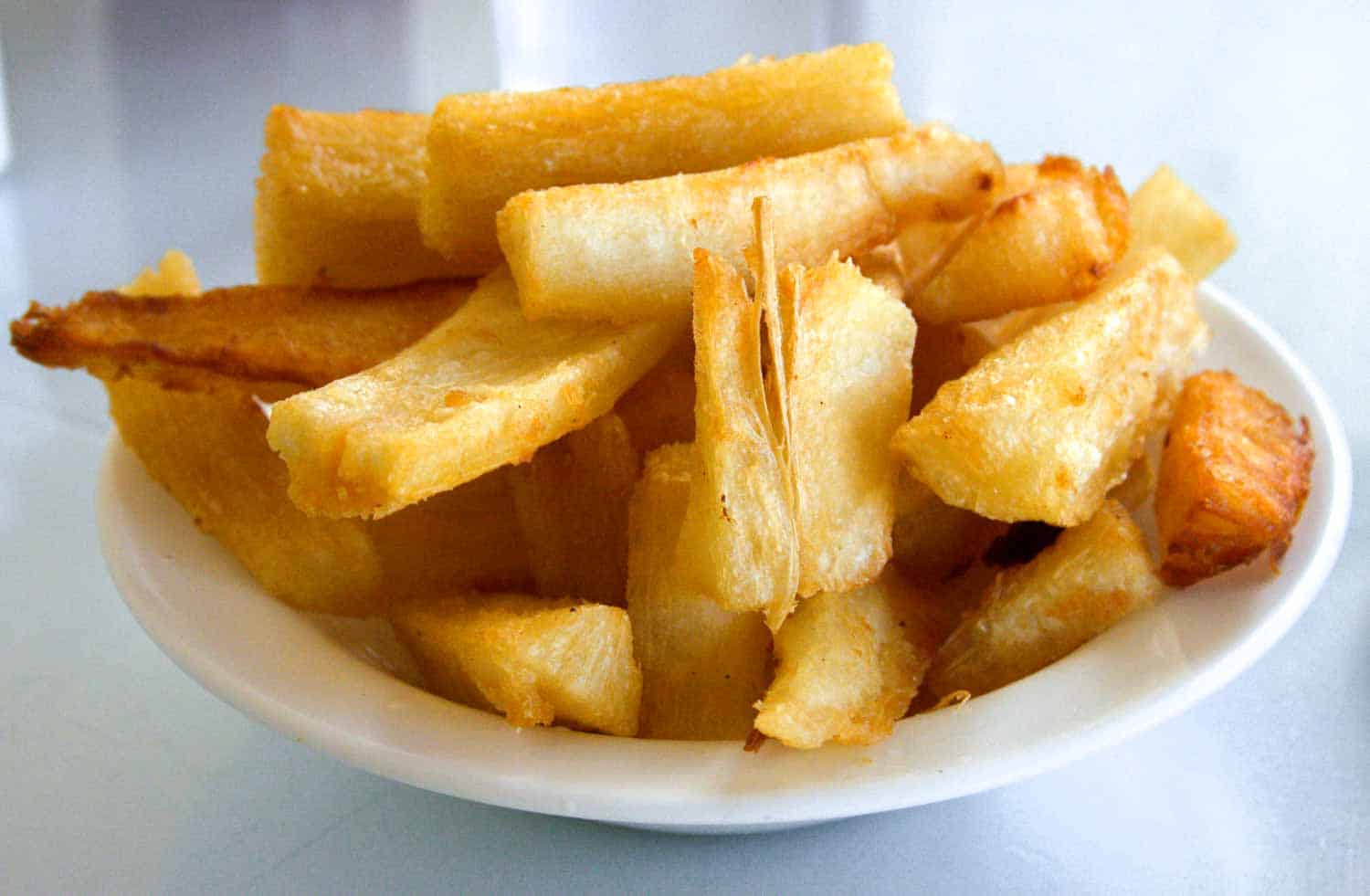
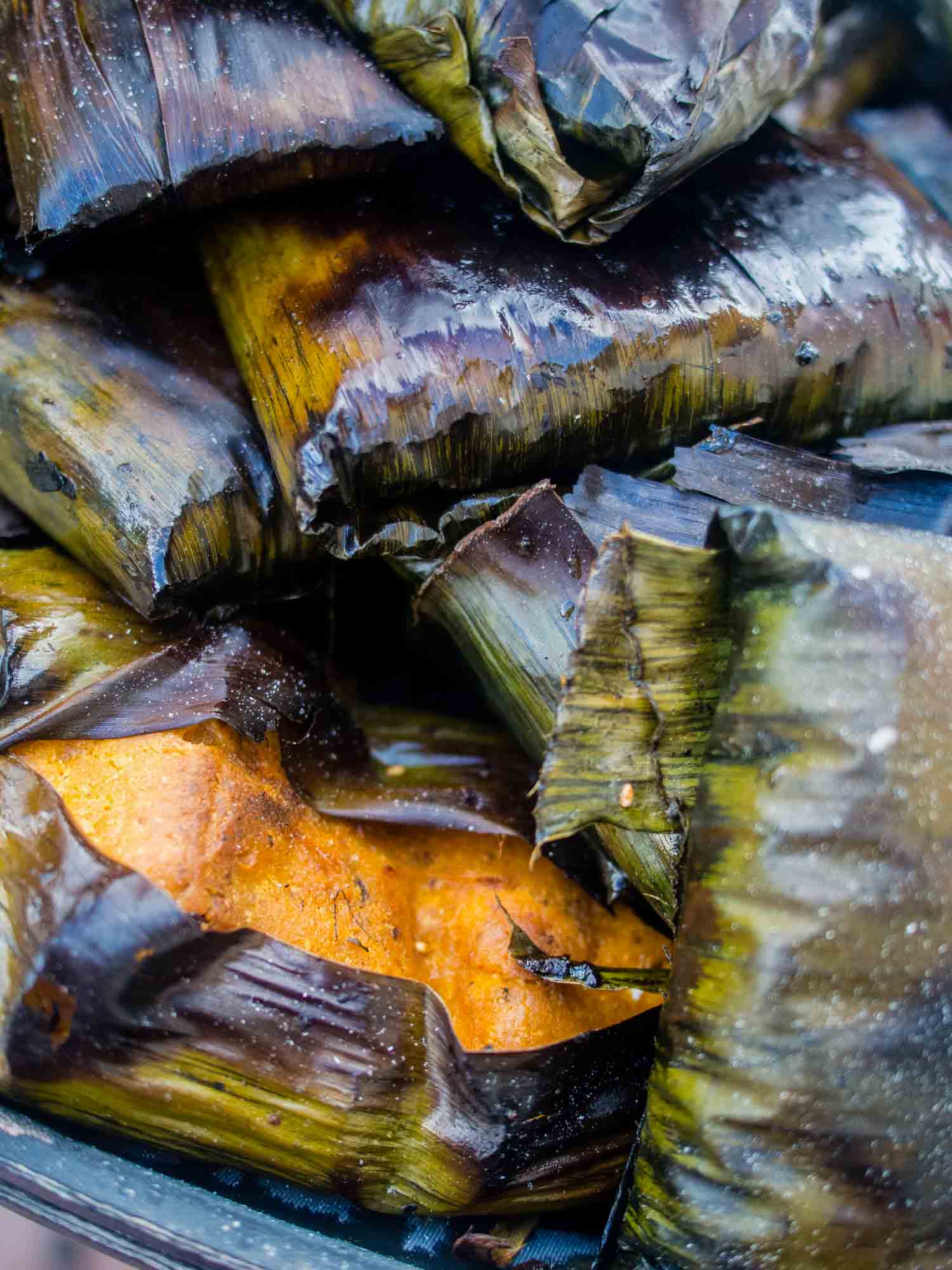
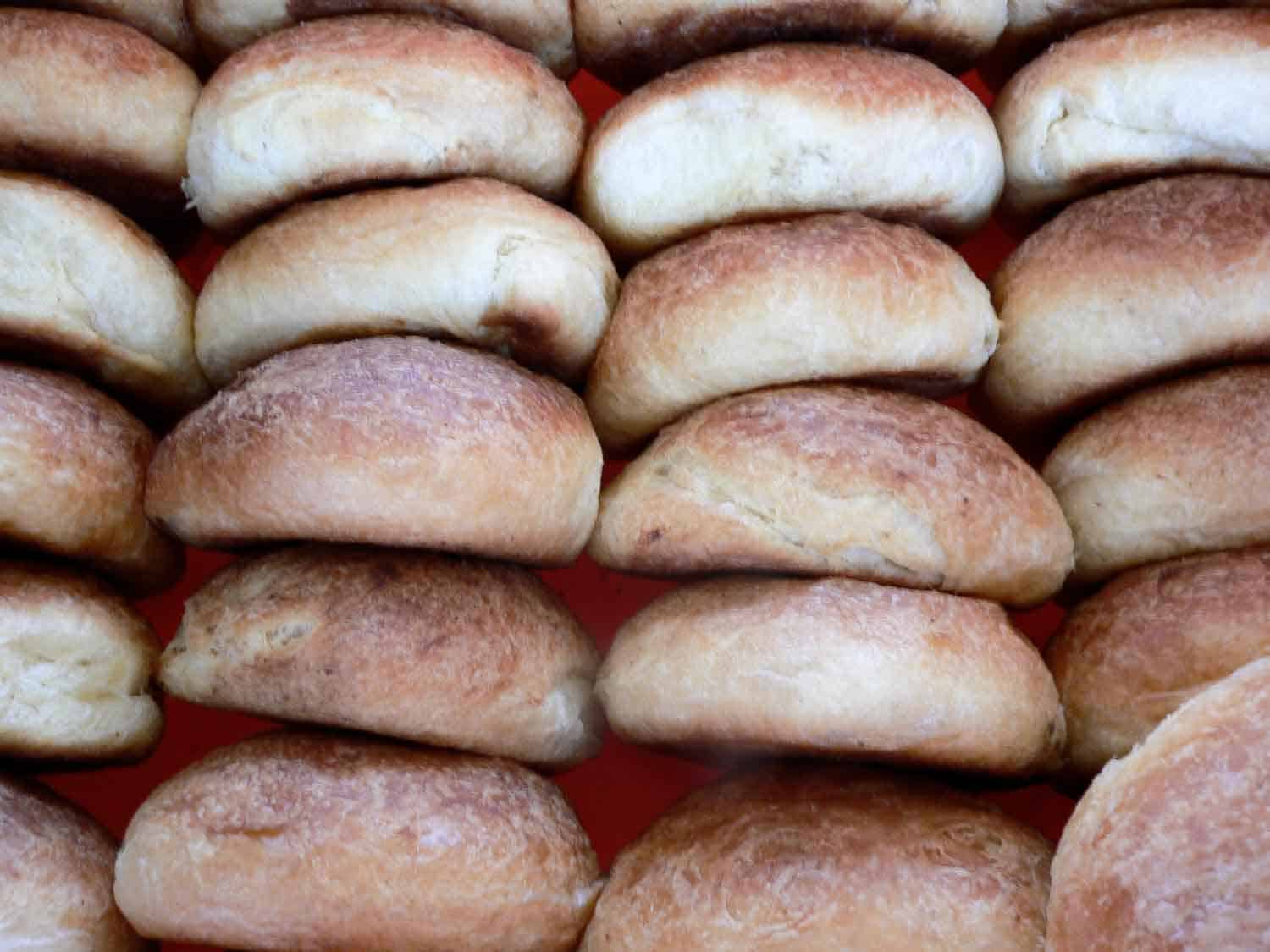
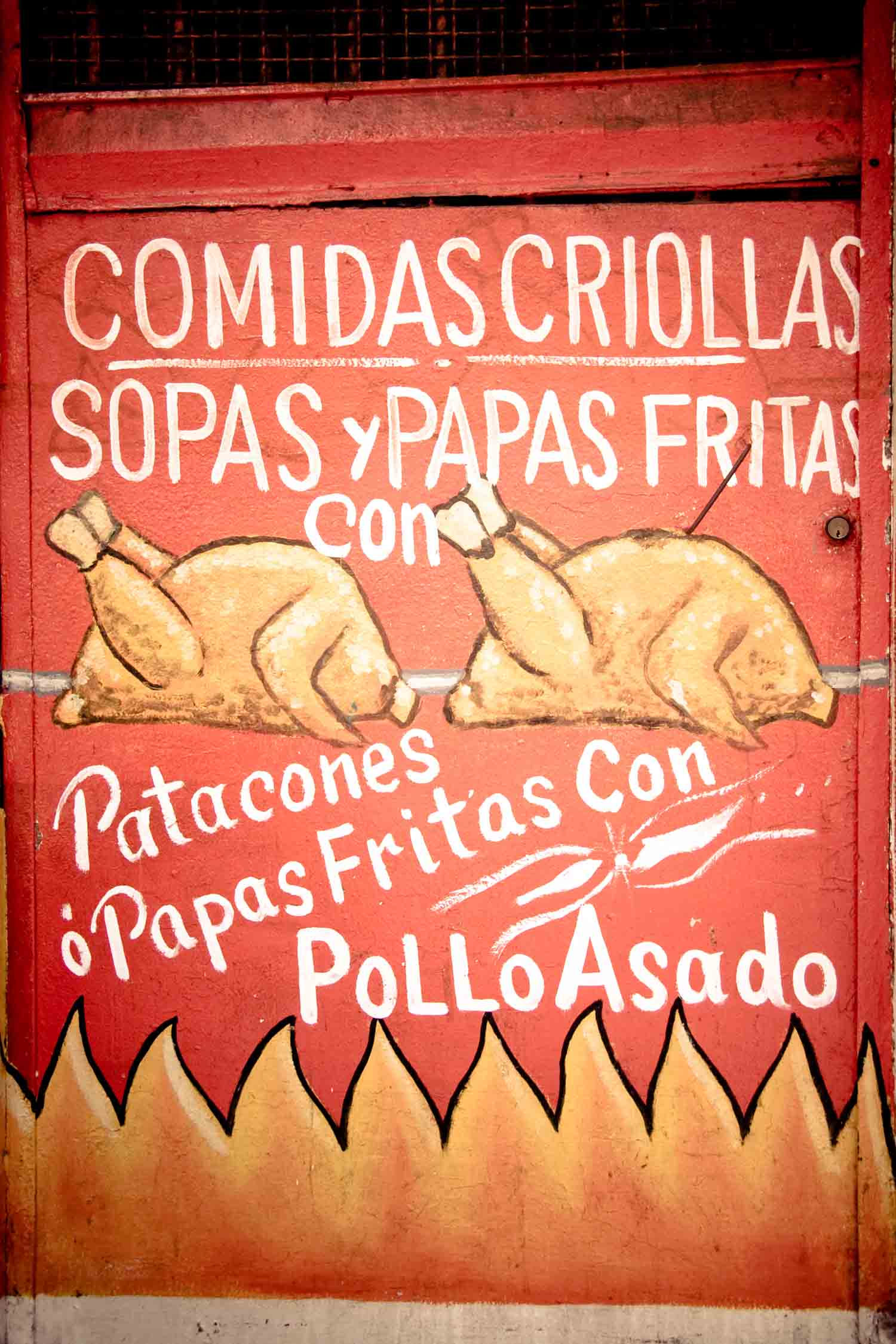
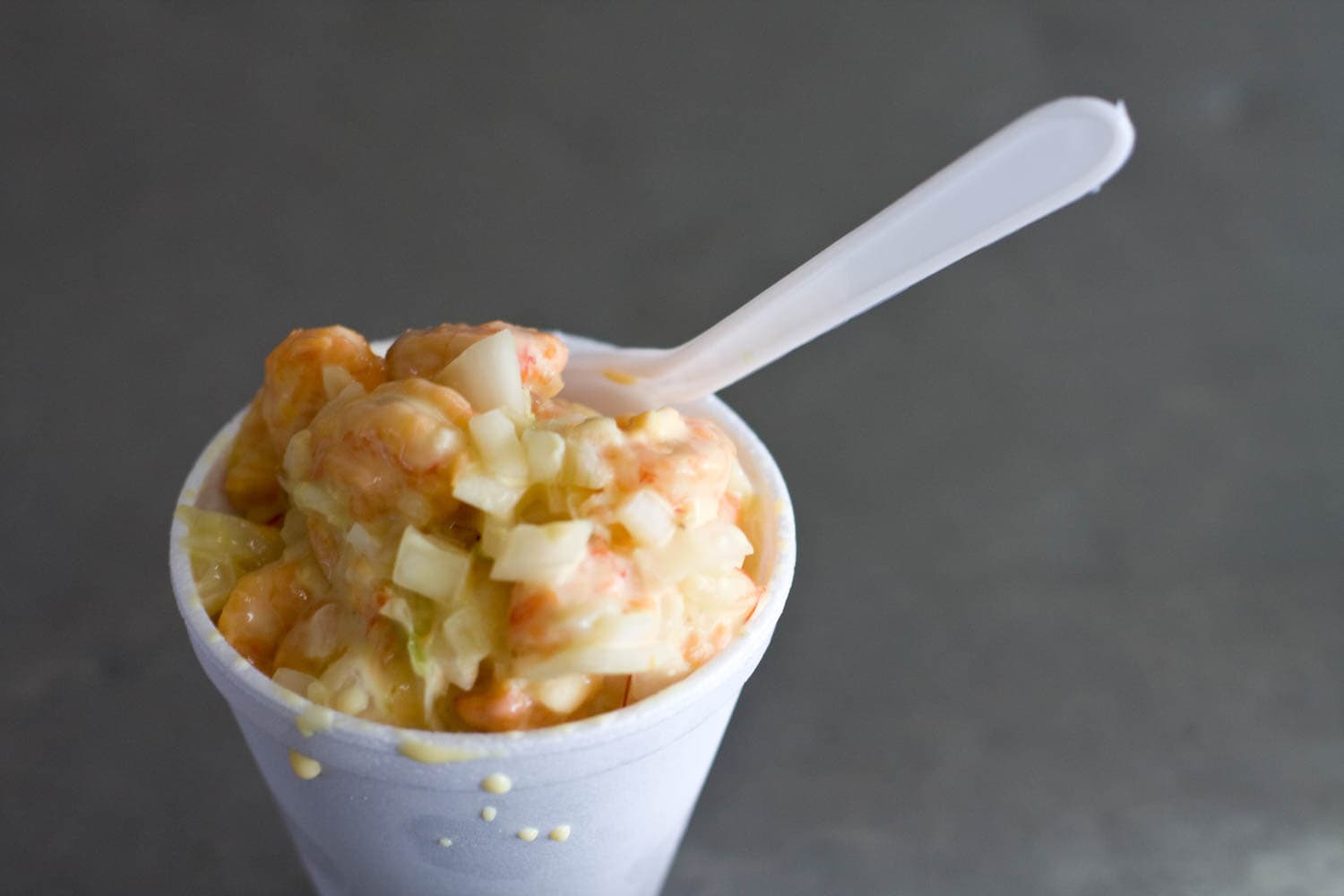
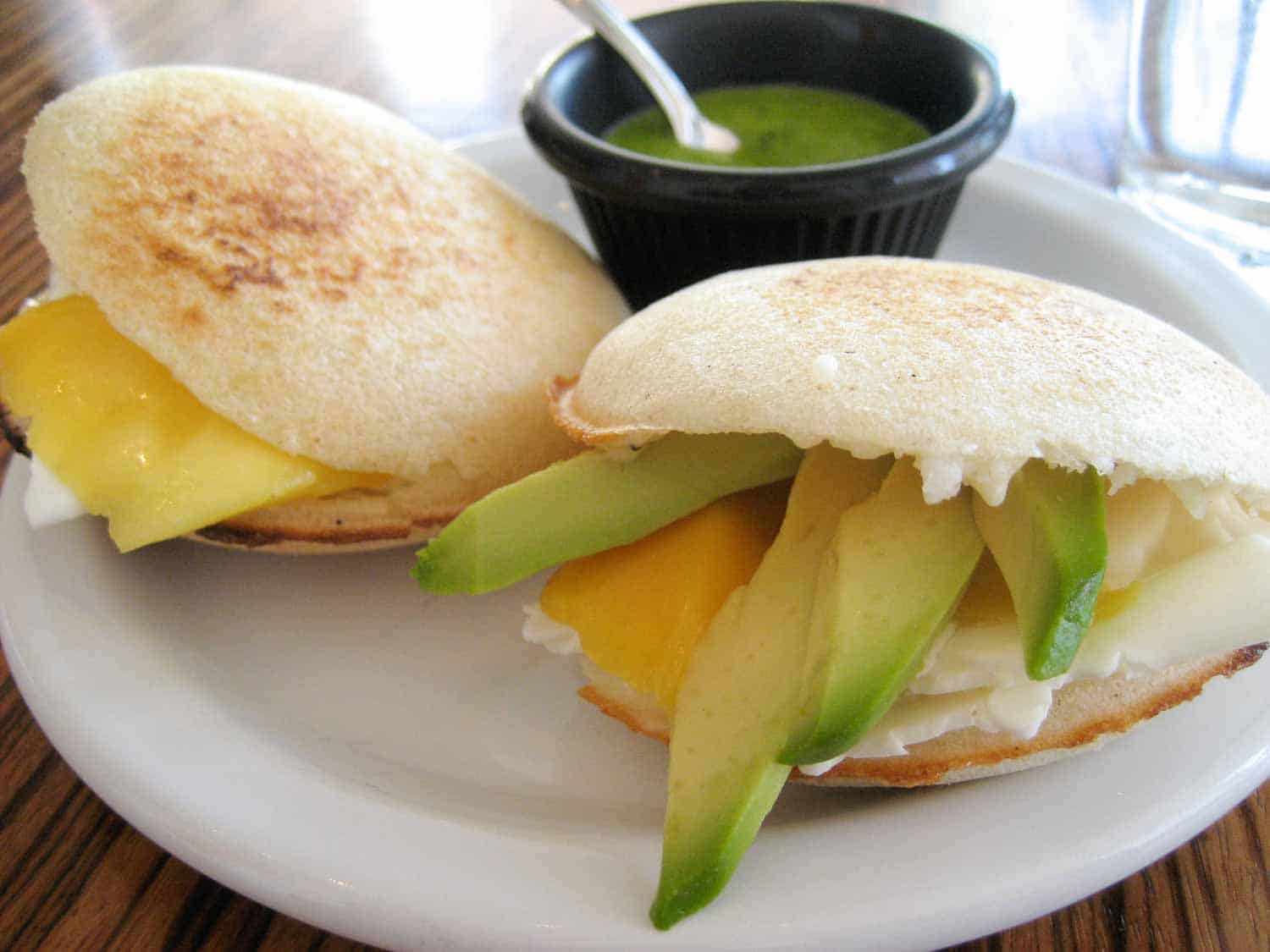
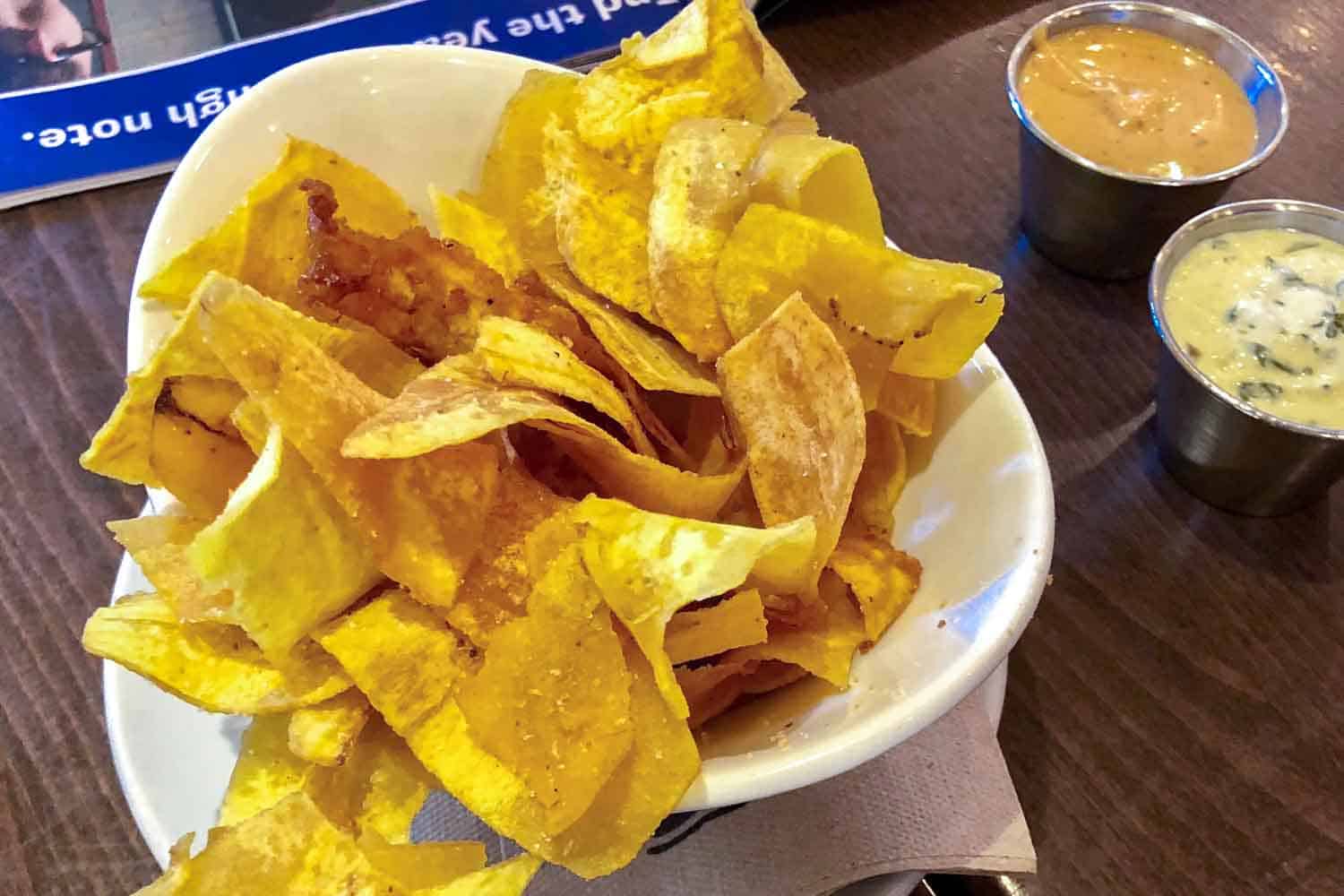
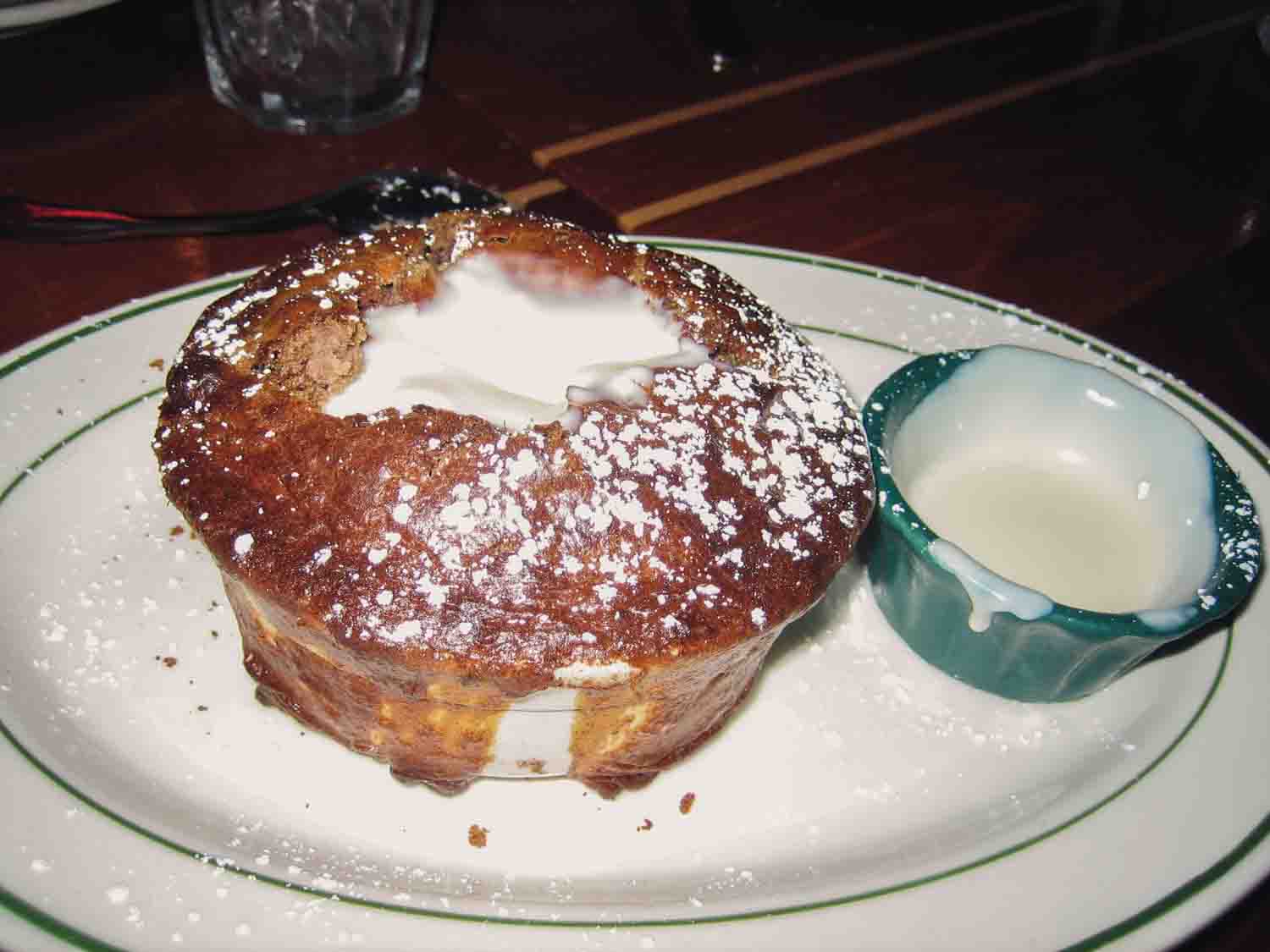
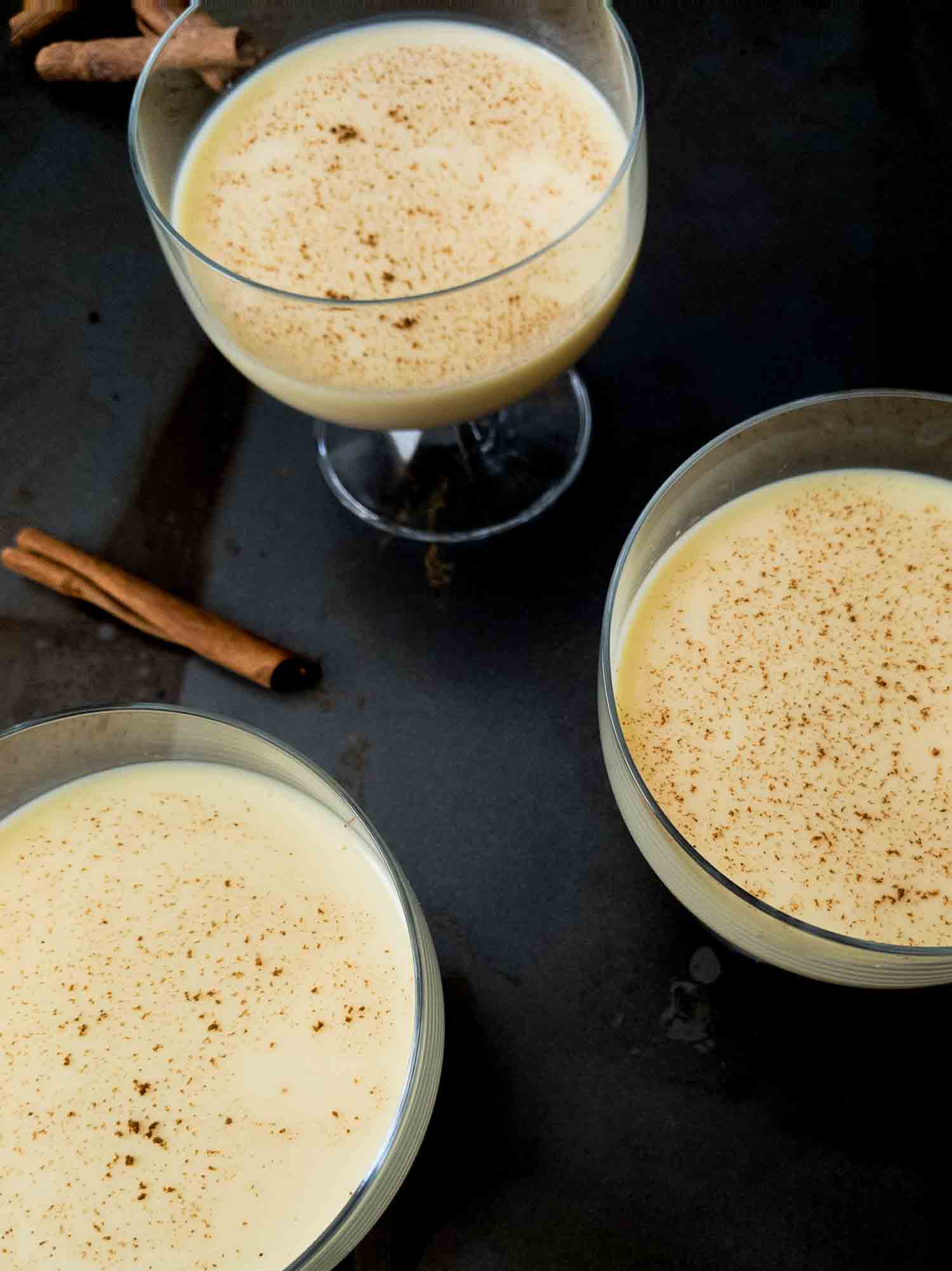
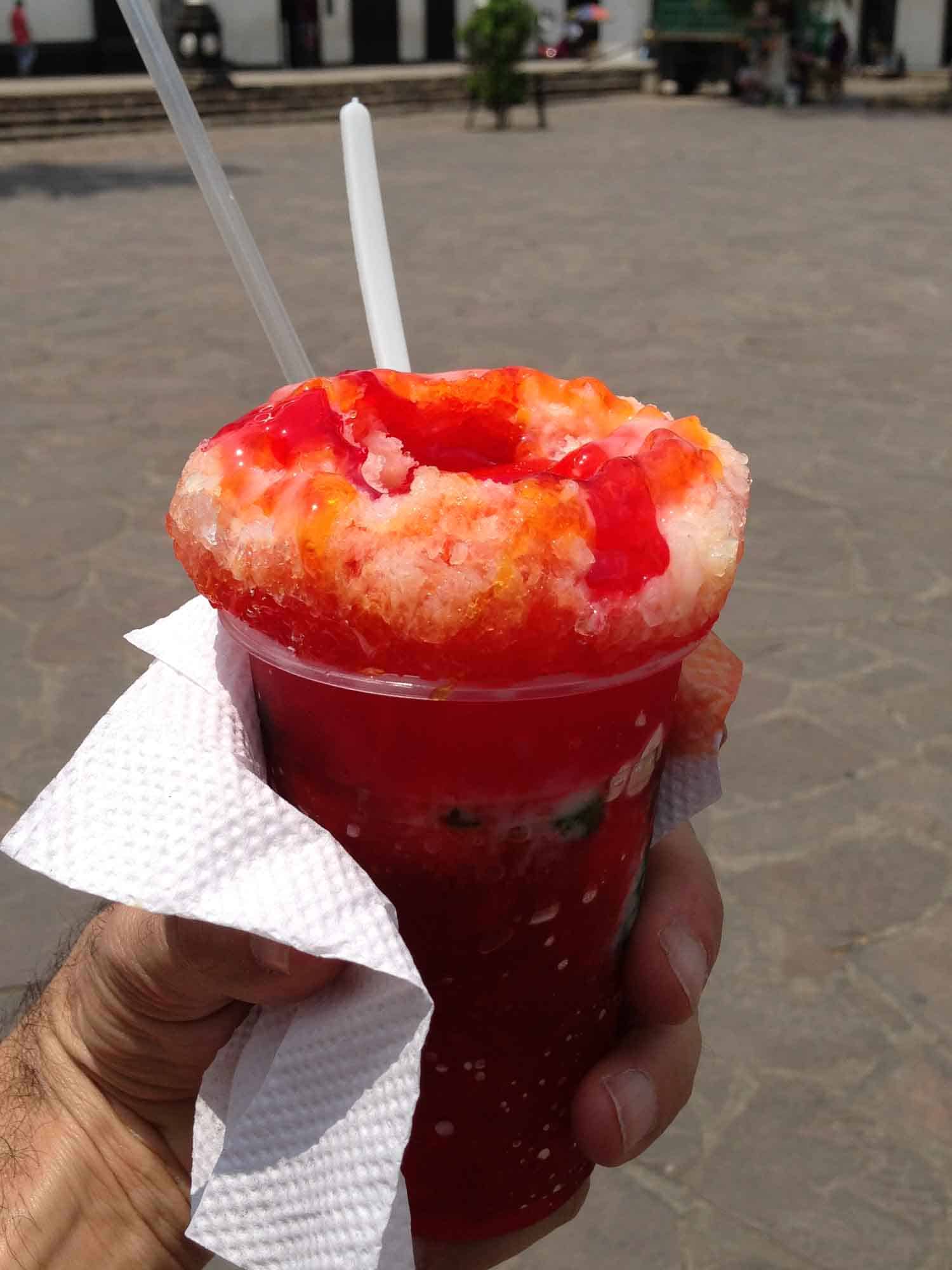
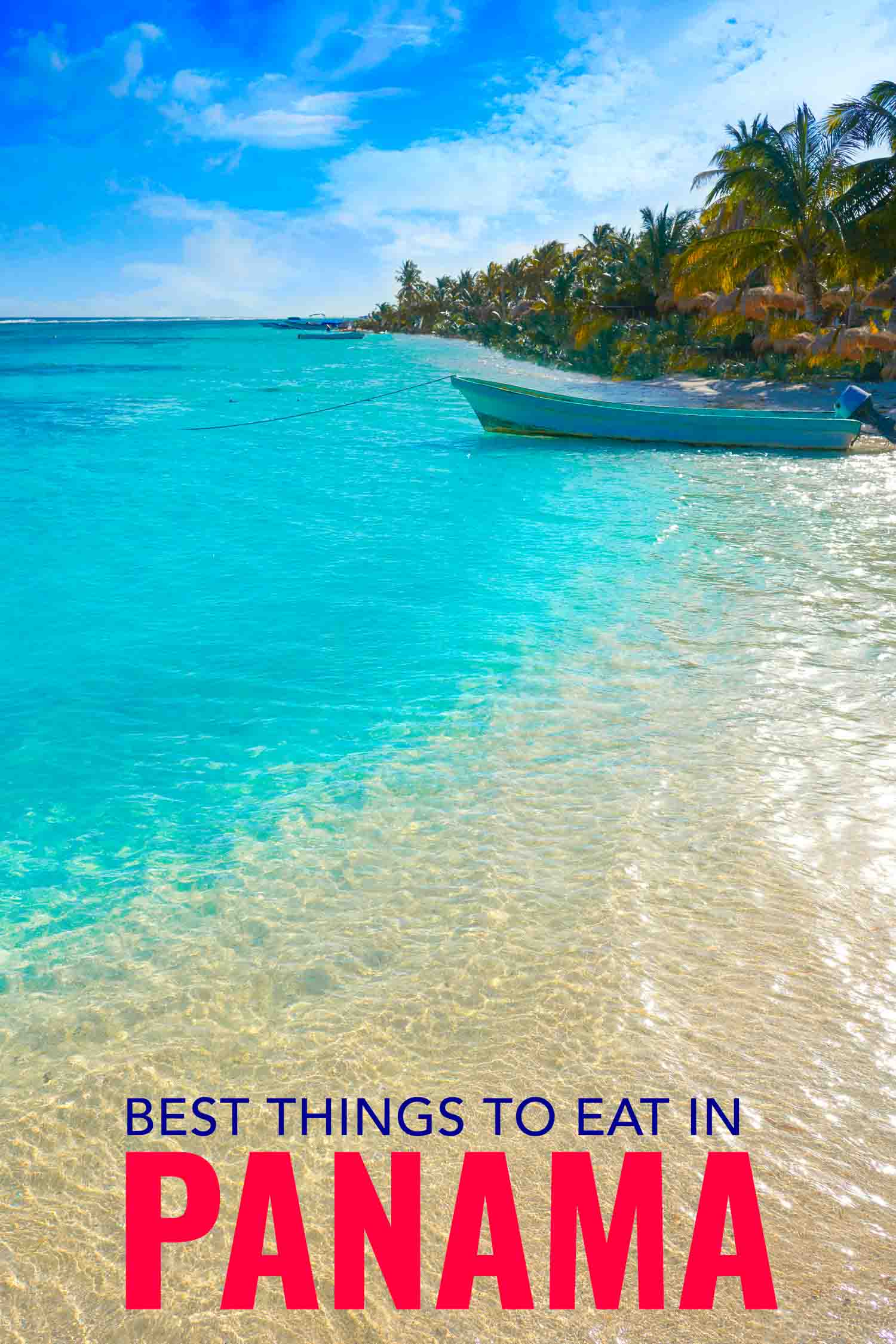
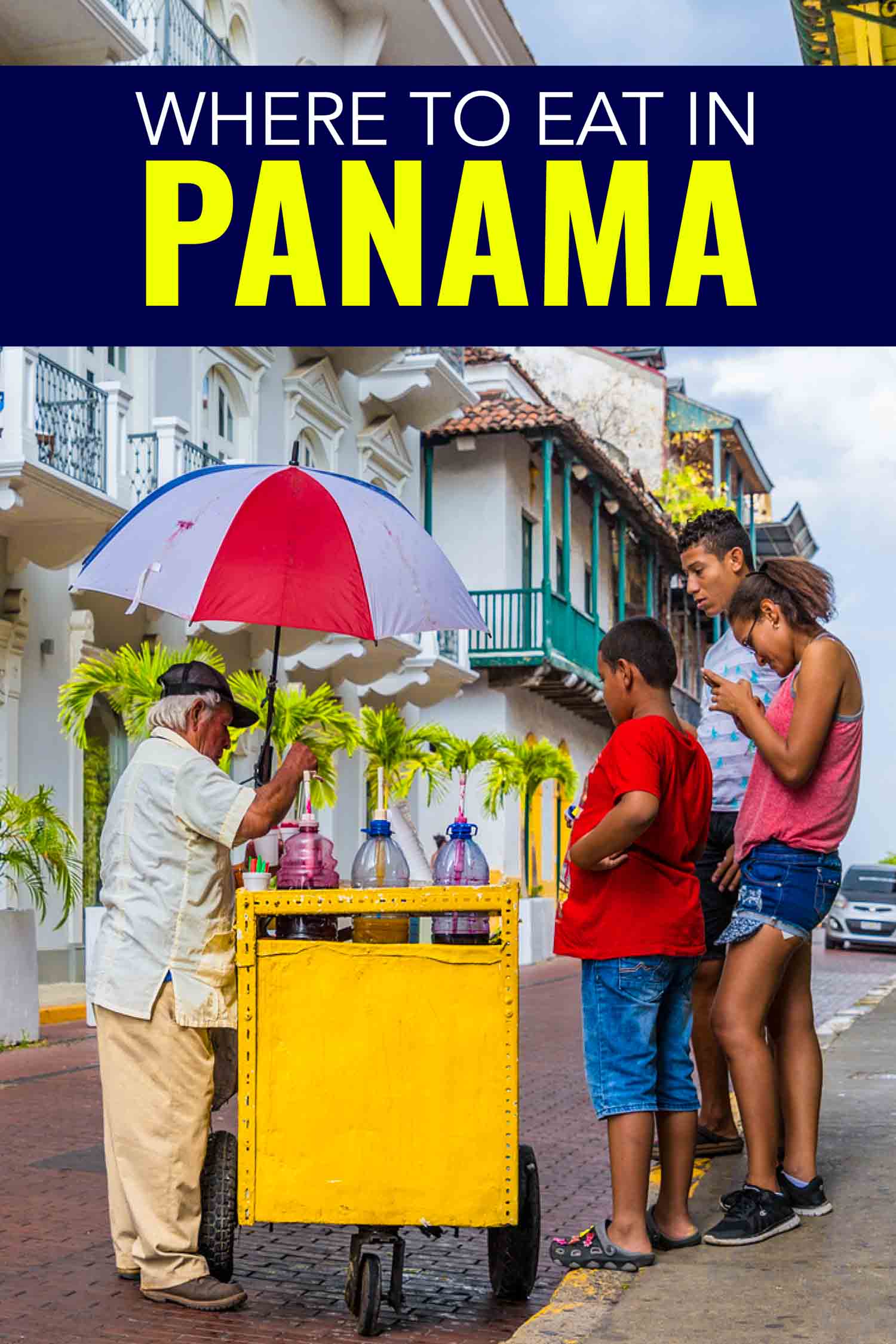
I am a foodie and I love trying the food from different cultures, great post.